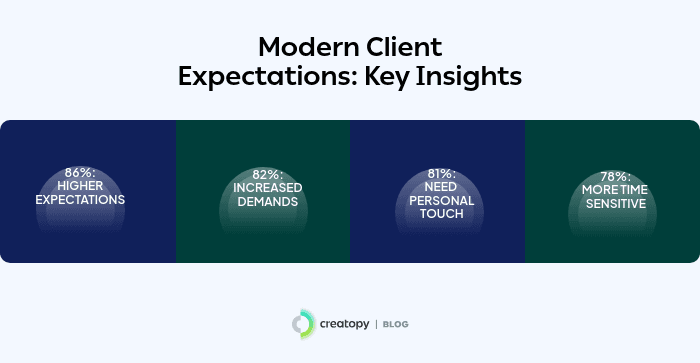Are you an agency? Scale your team's work and impact with The Agency Package.
Are you an agency? Scale your team's work and impact with The Agency Package.

Managing client expectations isn't just another item on your business to-do list anymore. Companies that excel at putting together a strong customer relationship management strategy perform better than their competitors. And if you're wondering just how important this strategy is, here's a number that might convince you: according to Grand View Research, the global CRM market is headed for a whopping $163.16 billion by 2030. Yes, you read that right!
Think about it—we're not just talking about basic customer service here. We're talking about crafting experiences that make clients stick around for the long haul. And the numbers, once again, back this up. According to Forrester, companies that put customers first grow 41% faster and keep 51% more customers than other companies. This shows why effective client expectation management methods have changed from being optional to being essential for long-term success.

You know that feeling when you check your phone after an hour and find three urgent client messages? Well, you're not alone. The client landscape has done more than just change—it's transformed entirely. According to Salesforce, 86% of customer service agents report that client expectations are reaching new heights, while 81% note that customers are increasingly looking for that personal touch. And let's be honest—this isn't just about updating your customer service management strategy; it's about reimagining how we connect with clients.
The challenge is finding the right balance between being available and setting limits. A study by InMoment shows that 94% of customers will spend more with businesses that let them communicate in their preferred way. This shows how important it is to create flexible but clear systems for managing client expectations and setting professional boundaries with clients.
Client preferences have also changed regarding response times and engagement. Salesforce reports that 82% of service staff say customers ask for more than they used to, while 78% say clients seem to be in more of a hurry. These changes mean businesses need to create strong systems that can meet higher expectations while keeping their teams healthy.

You've probably heard the saying "communication is key" so many times it's lost its meaning. But here's why it really matters in client management. As Roy H. Williams, bestselling author and marketing consultant, says:
The first step in exceeding your customer's expectations is to know those expectations.
Building communication systems that work for everyone involved is essential. So, what goes into a communication system that actually works? Let's break it down:
Setting up these systems requires careful thinking about what clients need and what teams can deliver. According to Salesforce, 74% of mobile workers say customers want more personal attention than before. Teams need to balance this desire for personal attention with practical, long-term communication methods.
Professional boundaries need careful planning and consistent follow-through. According to Ford's study of 16,086 people across 16 countries, 77% of professionals value personal life balance more than career growth. This shows that setting good boundaries actually strengthens client relationships rather than weakening them.
Clear boundary systems should include choosing specific times for client meetings and messages, so that everyone knows when to expect responses. Put these expectations in writing during the project start and client welcome materials. Even more, we all know that one client who thinks everything is an emergency. Therefore, create clear guidelines about what truly constitutes a drop-everything moment.
We also advise you to write down clear steps for handling requests that go beyond the original project scope, preventing project creep while keeping good client relationships. Create simple forms for change requests and clear pricing for extra work, making sure everyone understands costs upfront.
Setting professional boundaries goes beyond managing time. It means creating lasting systems that protect both clients and team members. Ford's research shows that 52% of working professionals would take a 20% pay cut for better work-life balance, showing how much people value healthy professional boundaries.
Today's client expectation management needs good tools and platforms. At The Brief, we know this need well and have built helpful features to manage client relationships better. Our platform lets teams create, organize, and share content with clients while keeping clear boundaries through permission settings and workflow tools.
The technology for managing clients keeps getting better. According to Grand View Research, cloud-based systems make up 58.2% of the CRM industry, showing that businesses prefer tools they can access and use together. Companies want platforms that can:
The Brief's tools address these needs while letting teams adjust to different client styles. From templates that adapt to your style to workflows that practically run themselves, we're all about making professional life easier while keeping those standards sky-high.
Customer experience expert Jeannie Walters shares,
Research tells us it takes 12 positive experiences to make up for 1 negative experience. Elite brands provide about 22 positive experiences for each negative experience.
This shows why teams need to keep interactions consistently positive while managing tough situations well.
Don't worry—we've got some tried-and-true strategies to help:
Successful client relationships require continuous evaluation and refinement of your management approach. According to Salesforce, 74% of mobile workers say customer expectations keep rising, making it important to track how well your client management strategies work.
Important things to measure include:
Good client expectation management leads to lasting partnerships. According to Forrester, companies that focus on customer experience get better business results. This success comes from consistently meeting expectations while keeping clear professional boundaries.
The retail sector leads the CRM market, according to Grand View Research, with growth driven by online shopping and mobile apps. This shows how important it is to maintain strong client relationships online while keeping professional boundaries.
So, what have we learned on this journey through managing client expectations? Think of it as finding that perfect balance between being there for your clients and keeping those professional boundaries strong enough to support long-term success. As we've seen, successful client management combines clear communication, strong boundaries, and effective use of technology. The numbers consistently show that organizations that prioritize customer relationship management strategy get better business results.
Looking forward, managing client expectations will become even more important as customer needs continue to change. By using the strategies and tools discussed in this guide, organizations can build stronger, lasting client relationships while maintaining the professional boundaries needed for long-term success. We find one truth as constant: future success belongs to those who can adapt their client management while keeping their professional standards strong.
7 days free on us
Let's put these insights into action. Build, scale, and automate campaigns with AI-powered workflows.